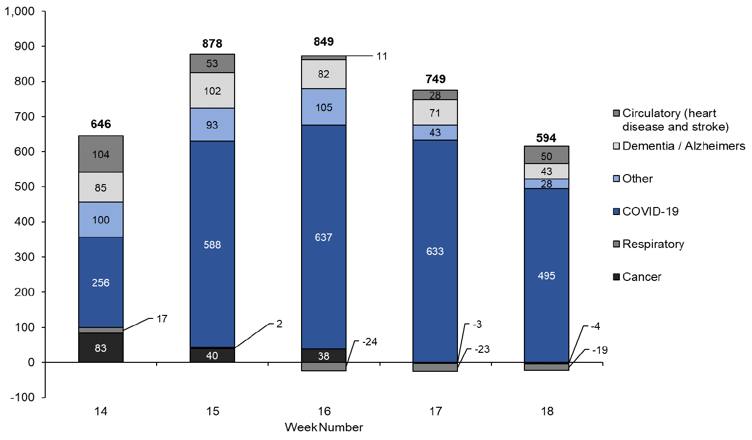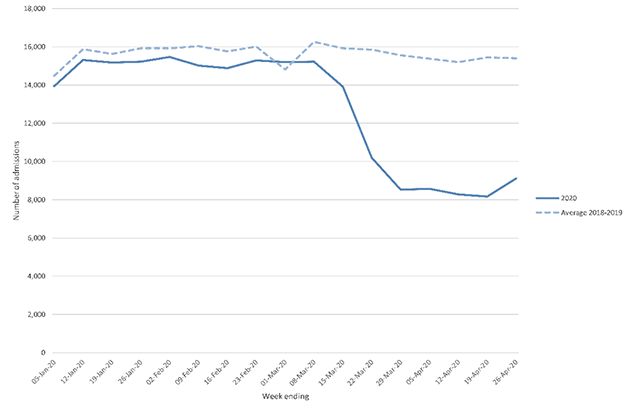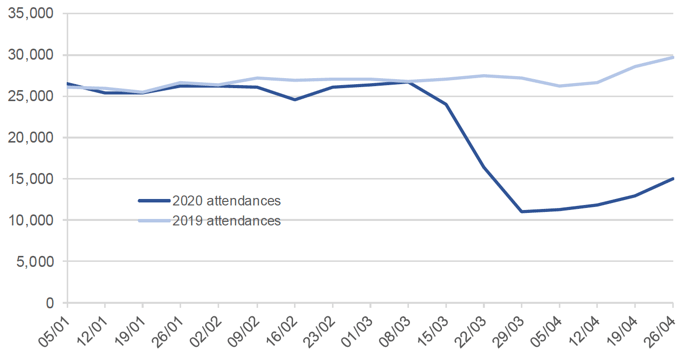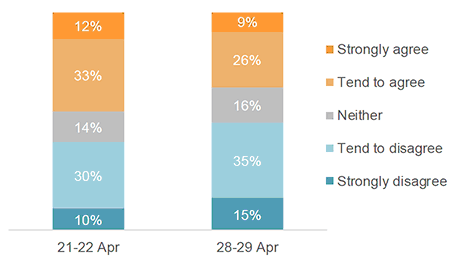Coronavirus (COVID-19): framework for decision making - supporting evidence
Analytical overview of the key analysis and evidence in support of COVID-19: framework for decision making - further information, summarising data and evidence on the various harms and wider impacts caused by the crisis.
This document is part of a collection
4. Health harms not directly related to COVID-19
COVID-19 is also having a wider impact on our health and social care through its impact on our health and social care services, how our people are using those services, the impact of mitigation measures, and how all three factors impact on health in the short, medium and long term.
Excess deaths are one indicator of whether wider health impacts are happening. The National Records of Scotland (NRS) data shows that Scotland has experienced excess mortality in the last 5 weeks.[6] There were 594 more deaths registered between 27 April to 3 May compared to the average for this time of year. Of these 594 excess deaths 83% were deaths where COVID-19 was the underlying cause of death; 8% were due to an increase in deaths from circulatory diseases; 7% came from an increase in dementia and Alzheimer's disease deaths and 5% were due to an increase in deaths from other causes.
Figure 5 shows the number of excess deaths over the latest five weeks broken down by the underlying cause of deaths. Most of the excess mortality experienced in Scotland can be explained by the numbers of excess deaths where COVID-19 was an underlying cause, but not all. Public Health Scotland are now exploring this further.

There are changes in some measures of health service performance and capacity, some of which can be explained by measures introduced to create capacity in the NHS to manage in the first phase on the pandemic. Overall acute hospital bed occupancy is at 65%. Pre-COVID occupancy was around 87%. Routine elective surgery has been postponed and emergency admissions are lower than the levels we saw pre-COVID.
Public Health Scotland analysis published on 6 May shows that planned admissions to hospital started to decrease on 16 March as hospitals began to create capacity to cope with anticipated pressure from COVID-19. There has been about a 30% reduction in the level of emergency admissions and a 60% reduction in the level of planned admissions.

There has also been a reduction in accident and emergency attendances. This overall reduction could have a number of possible causes, such as fewer traffic and workplace related injuries or reluctance or anxiety about using services. There was a 54% decrease in attendances in April 2020 compared to April 2019 at core Emergency Department sites. However, Figure 7 shows the recent increase over the last two weeks, suggesting that service use for non COVID-19 related health matters is picking up again but clearly remains below pre-COVID levels.

The YouGov Weekly Scotland survey shows that some people would avoid going to a hospital or GP practice with non-COVID immediate medical concerns (Figure 8). However, the percentage strongly or tending to agree with the statement has reduced between the first survey on 21-22 April and a second survey on 28-29 April.

We also know that the restrictions necessarily put in place to slow the spread of the virus can, in turn, cause harm to our population health. Significant work is underway to understand and mitigate the effects on physical health and mental health and wellbeing.
Around 170,000 adults in Scotland have been defined on medical grounds as clinically extremely vulnerable due to having an existing health condition that puts them at very high risk of severe illness from COVID-19[7]. An additional group of people are advised to follow enhanced social distancing, because pre-existing health conditions or circumstances mean they are at increased risk of severe illness from COVID-19[8].
Among British adults responding to the ONS Opinions and Lifestyle Survey in the period 7-27 April 2020, 48% said their well-being was affected by COVID-19. About 3 in 4 (75%) of those who said their wellbeing was being affected said they were feeling worried about the future, with over 6 in 10 (63%) feeling stressed or anxious and over half (53%) feeling bored. Over 4 in 10 (43%) also said not being able to exercise as normal was impacting their wellbeing.[9]
Finally, Public Health Scotland and collaborators have published a paper on the risks of distancing measures negatively impacting on people's health, and how to mitigate these wider harms[10]. It finds that the interventions in place to lower transmission of the virus can themselves cause a wide range of harms and that building a more sustainable and inclusive economy for the future will be crucial to mitigating these wider harms.
Contact
Email: CovidExitStrategy@gov.scot
There is a problem
Thanks for your feedback